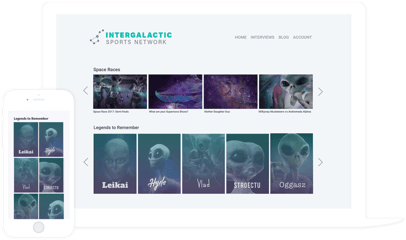Channel surfing is officially dead. Consumers don’t want more content options, they want curated options so they can quickly find and discover content that they **actually** want to watch. Streaming services such as HBO and Netflix have capitalized on the demand and need for curation by leveraging viewer’s data to serve them the most relevant content possible. It’s no surprise that streaming services are on the rise, a personalized experience simply isn’t feasible for linear TV.

Curation isn’t just something that consumers demand, it also plays a vital role in the growth of a streaming service. In order to successfully engage and retain online audiences in today’s attention economy, video businesses must deliver a Netflix-quality (easy, attractive, and most importantly, personalized) experience to consumers across devices.
Driving Viewer Engagement
The whole goal of curation is to make sure your viewers spend less time finding what they want to watch, and more time actually engaging with your content so they keep coming back to watch more. The reality is, every second….every moment counts to keep viewers engaged, which is precisely why a carefully crafted viewing experience is absolutely critical to your business' success.
Every size video business can (and SHOULD) integrate curation into their strategy, it doesn’t take a complex algorithm or mountains of audience data to get started. In fact, with the right tools and some thoughtful planning, curation is super simple. It boils down to organizing and structuring content in an intuitive way on the backend, that in turn drives better viewer engagement on the front end.
What’s the best curation method?

1. Organize content with a game plan
Before you can start curating your content, you’ve got to get organized. Although viewers won’t see how content is internally tagged and segmented on the back-end, it will determine how they navigate and find content on the front-end. Like any sports team, before you can play the game, you have to know the players, what their positions are, and have a strategy to win the game. You want to approach content curation with the same mindset. In order to give viewers a seamless experience, it’s important to start with a well designed and carefully thought out plan for how you want to structure your content.
2. Drive engagement and clean design using metadata
What was it that made you click on the last video you watched on Netflix? Most likely it was a thumbnail that caught your eye or a clever title that sparked your curiosity. A video’s thumbnails, titles, and descriptions (aka metadata) not only provides the viewer context, it also determines how the audience views content and it has the power to gain or lose the viewer’s engagement. Clean design is the foundation of a delightful and seamless viewer experience, so it’s important to carefully craft your metadata in a way that you know will successfully capture your audience’s attention.
3. Consider the psychology behind the structure
It’s time to get inside your audience’s head. In order to provide viewers with an experience that is tailored to their individual needs and interests, you’ve got to know exactly what they want. As a content owner, you know your audience better than anyone, so before you structure your content and start creating playlists, consider how your audience searches for content and what they came to watch. Do they come with a purpose and search based on a specific personality or series? Or do they want to discover something new based on a particular category or genre they’re interested in. It’s important to use a mixture of intuitive and guided structuring so that viewers can easily find what they came to watch, as well discover something new.
4. Use audience data to continually optimize
You won’t nail down the best way to curate your content on your first try, and that’s okay. Curation isn’t something you can just set and forget, in order to have an impact it must be something that evolves and grows alongside your content and audience. Which is exactly why it’s important to continually optimize your curation method. Don’t be afraid to switch up your typical playlists or test a new approach—even if it doesn’t work, you’ll learn something new about your audience. Leverage analytics and continue to gather data from your viewers to sharpen your insights as you evaluate what's working and identify where you can make adjustments.
Ready to go beyond the basics? Watch this webinar to learn more advanced ways to structure and curate your content using automatic workflows, category tags, nested playlists and more.